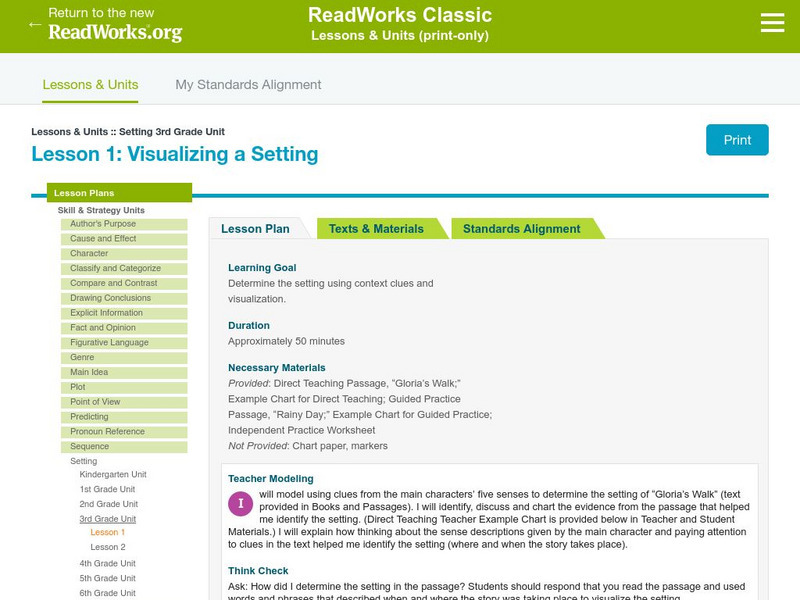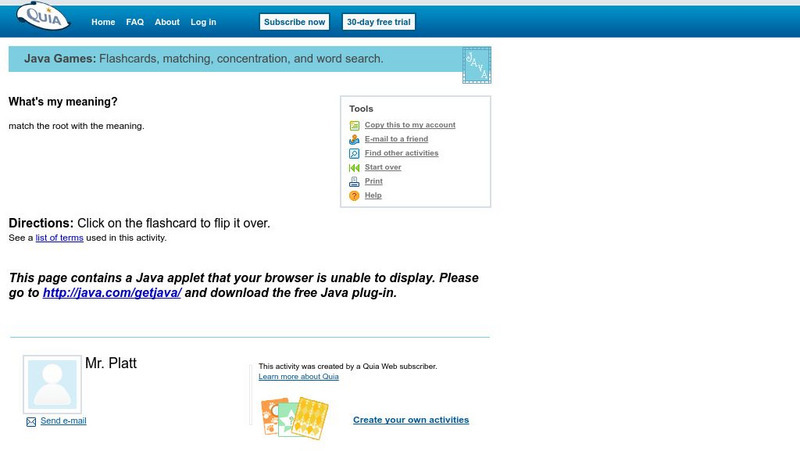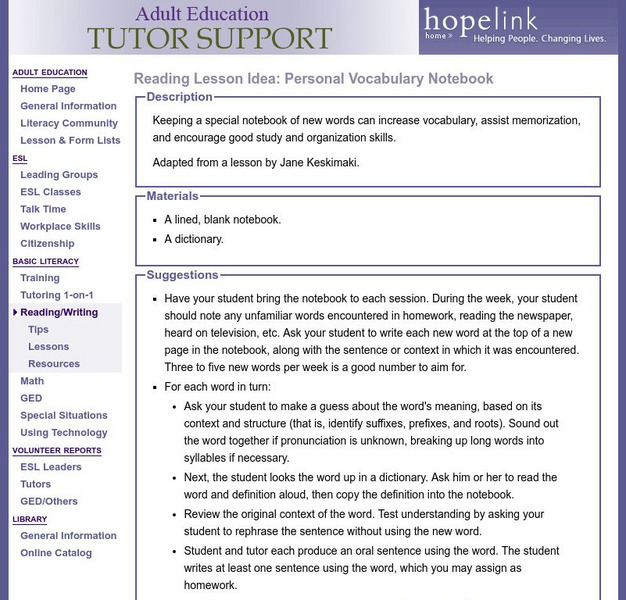Reading Rockets
Reading Rockets: Reading Topics a to Z: Scientific Language in Primary Grades
Research on the importance of teaching scientific language usage, ideas for utilizing scientific language, and rubrics for assessing student use of scientific language in grade schools.
Read Works
Read Works: 3rd Grade: Lesson 1: Visualizing a Setting
[Free Registration/Login Required] In the course of this lesson plan, 3rd graders will learn to determine the setting of what they read by using context clues and visualization.
Writing Fix
Writing Fix: Details and Vocabulary: Using Content Based Vocabulary
In this lesson plan, students will write a descriptive paragraph regarding an animal and its habitat, or a character in a particular setting. Great cross-curricular usage of vocabulary.
Writing Fix
Writing Fix: Noun Inspired Animal Reports
For this lesson students will complete a report regarding an animal for science class. Vocabulary, nouns and verbs can be incorporated cross-curricularly.
Writing Fix
Writing Fix: Character Credo Poems
Build your student's vocabulary, word choice and voice by asking them to write from the perspective of a particular character. Lesson plan incorporates the R.A.F.T.S. strategy: role, audience, format, topic and strong verb.
Curated OER
Mc Graw Hill: Part 2 Reading: Informational Text: Understand Content Words
A reference page that shows you how to use context clues to figure out the meaning of unknown content words.
Curated OER
Mc Graw Hill: Part 2 Reading: Informational Text: Cause and Effect Text Structure
Cause and Effect is a text organization structure and knowing this structure can help you in comprehending a text. Learn about these strategies on this site.
ReadWriteThink
Read Write Think: Dynamite Diamante Poetry
Contains plans for five lessons that teach about parts of speech, gerunds, and vocabulary by having students write diamante poetry. In addition to objectives and standards, this instructional plan contains links to sites used in the...
ReadWriteThink
Read Write Think: Technical Reading and Writing Using Board Games
Contains plans for a game that helps teach technical reading and writing while reviewing a novel that learners have read. In addition to objectives and standards, this instructional plan contains links to sites used in the lessons as...
ReadWriteThink
Read Write Think: Using Narrative for Expository Text
Lesson in which young scholars read various narrative texts which provide a context for them to learn content-area topics. Narratives allow the students to begin to understand expository texts.
Quia
Quia: What's My Meaning
These virtual vocabulary flashcards display the root words on one side and their meanings on the other.
Other
Live Worksheets: Question Words
This interactive worksheet features interrogative sentences with missing question words. Students will type in one of following words or phrases into each sentence: who, what, where, why, when, how, and more. Students will then submit...
Hopelink
Hopelink: Reading Lesson Idea: Personal Vocabulary Notebook
This site has a simple but direct approach to building your vocabulary. Keeping a special notebook of new words can increase vocabulary, assist memorization, and encourage good study and organization skills. L.11-12. 6 Vocabulary
Curated OER
Mc Graw Hill: Part 2 Reading: Comparison and Contrast Text Structure
A reference article showing reading strategies to understand text structure of comparison and contrast.
Wisconsin Response to Intervention Center
Wisconsin Rt I Center: Frayer Model [Pdf]
Classroom teachers will learn about the Frayer Model, an engaging instructional strategy tool. Teachers will learn how to implement the Frayer Model, understand how to measure progress with the Frayer Model, find research that supports...
Writing Fix
Writing Fix: About Frogs
Students read picture books, complete science worksheets, and draw illustrations to show their understanding of the life cycle of frogs.
Other
Thoughtful Learning: Minilesson: Asking and Answering the 5 W's and H Questions
Students will learn the "5 W's and H questions" needed to comprehend a news story. Then students will apply these question words [who, what, where, why, when, and how] to real news stories and to events in their own lives.
Read Works
Read Works: Fit for Life
[Free Registration/Login Required] This passage explains concepts related to a healthy diet. This passage is a stand-alone curricular piece that reinforces essential reading skills and strategies and establishes scaffolding for...
Read Works
Read Works: Tossing Around Dodgeball
[Free Registration/Login Required] This passage shares the pros and cons associated with the game of dodgeball. This passage is a stand-alone curricular piece that reinforces essential reading skills and strategies and establishes...
Read Works
Read Works: The Great Escape
[Free Registration/Login Required] This fiction story shares the story of a girl who is taking care of animals and makes a mistake. This passage is a stand-alone curricular piece that reinforces essential reading skills and strategies...
Utah Education Network
Uen: Lesson Plan: Learn New Words
Lesson plan uses Penquin Post by Debi Gliori to teach students how to use context clues to determine the meaning of new words and to build vocabulary acquisition skills.
ReadWriteThink
Read Write Think: Acquiring New Vocabulary
This lesson teaches elementary students new vocabulary terms through book discussion groups. Students use context clues, prior knowledge, and print and online resources for vocabulary understanding in their discussion.
Wisconsin Response to Intervention Center
Wisconsin Rt I Center: Interactive Word Walls [Pdf]
Classroom teachers will learn about interactive word walls, an engaging instructional strategy. Teachers will learn how to implement word walls, find research that supports the practice, and find examples.
Read Works
Read Works: Organizing Information Into an Outline
[Free Registration/Login Required] In this activity, students will take notes as they read Animal Homes by Ann O. Squire. This information will then be organized into an outline. Includes printable materials for teacher and students.





















